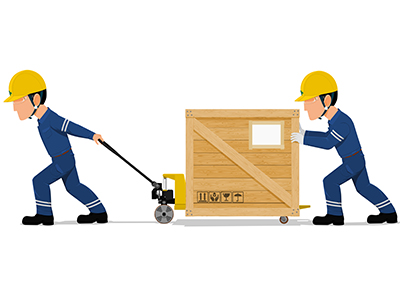And lift! Approaching manual handling risk assessments
Monday, 17 September 2018
Around nine million working days are lost each year due to work-related musculoskeletal disorders according to the Health and Safety Executive (HSE).

Manual handling is listed as one of the main causes of work-related musculoskeletal disorders. So what can businesses do to protect their workers?
The first thing is to recognise that manual handling covers a whole range of different activities, not just lifting things, for example pulling/pushing trolleys and even just holding things up in the same position for a while (static loading). You’ll know just from normal everyday activities (and the twinges you get) that things like weight, awkwardness of the load and how often you need to move it are important determinants of injury potential.
The answer to most manual handling risks is NOT to avoid manual handling altogether but to be sensible, proportionate and pragmatic. Manual handling can be good for health. There are obvious benefits to be had from the physical activity and obvious dangers in becoming increasingly sedentary by avoiding it. However, we do need to recognise and avoid extreme manual handling (such as very heavy, unstable loads) and to use tools (like sack trucks, conveyers, cranes) to make it easier and less risky. Though of course, using additional equipment brings its own risks, so the aim is to reduce the risk overall. People can be tempted into risky manual handling when they want to do things quickly, they don’t have the right equipment (or it isn’t handy) or something unexpected happens. Many long-term manual handling-related injuries are typically not down to a single, one-off event but to repeated poor practice that eventually gets the better of you.
One of the common threads in health and safety is the need for risk assessment. This has made its way into manual handling too. The key to risk assessment is making sure that all relevant risk factors (i.e. the things that actually have a bearing on the likelihood or severity of the injury) are taken into account. That’s why the detail of what to look for in risk assessments for specific types of risks (like manual handling, chemicals, noise) is different, even though the approach is similar.
One of the best things about the idea of a manual handling risk assessment is that it gets you to stop and think rather than just ploughing ahead. The thought of it is often worse than doing it though. In common with many types of risk assessments, the level and detail of your risk assessment also needs to be proportionate to the risk. If you have to fill in a 42 page risk assessment form to lift a pen, guess what? It won’t get done! But there is no need to formally assess trivial risks (I think most people can manage carrying a sheet of paper…) – that simply ends in a paper chase.
Simple risks can be assessed using simple methods and more complex tasks can be assessed using more involved methods. In fact, the HSE themselves have a range of risk assessment tools for different manual handling tasks that are designed to help. These range from simple check lists to more advanced evaluation tools for specific types of tasks, such as Manual Handling Assessment Charts (MAC), Risk Assessment of Pushing and Pulling (RAPP) or a full Manual Handling Risk Assessment (MHRA).
Some people think that you have to be an expert in health and safety to do any risk assessment, however simple the task you are assessing. The truth is that some risk assessments are relatively simple and easy (for low/medium risk activities) and the solutions relatively obvious (like a sack truck or trolley or simply dealing with smaller packages). By reading the relevant official guidance, many people can do these simpler risk assessments without any special training. You just need to know what you’re looking for. Indeed, HSE states that “[The manual] assessment may best be carried out by members of staff who are familiar with the operations in question, as long as they have the competencies to do so.”
Of course, complex tasks and high hazard industries require competent specialists to carry out assessments but don’t be afraid of assessing simple risks yourself. There is plenty of guidance available and the resources mentioned earlier give you a step-by-step list of questions to help you assess activities.
